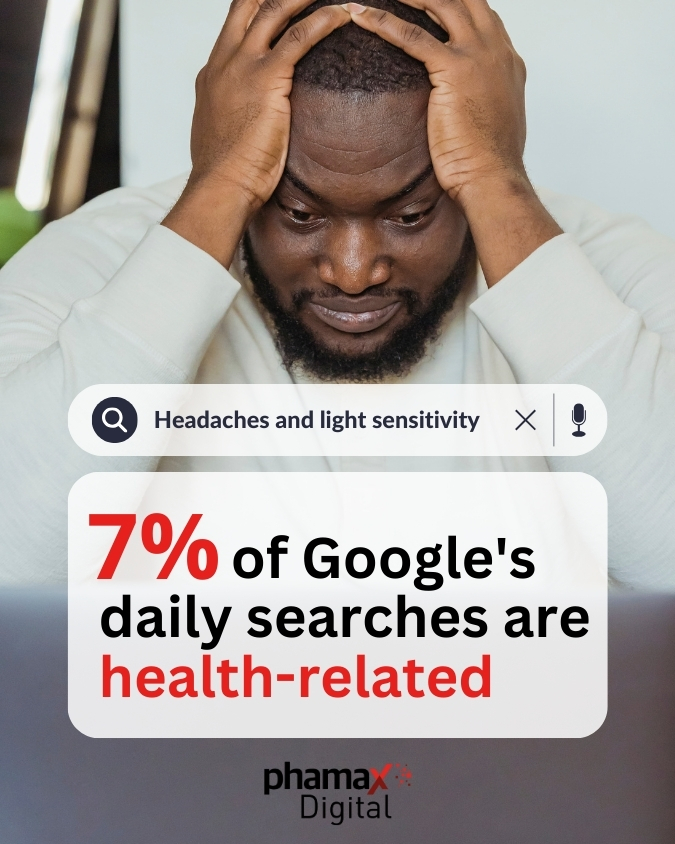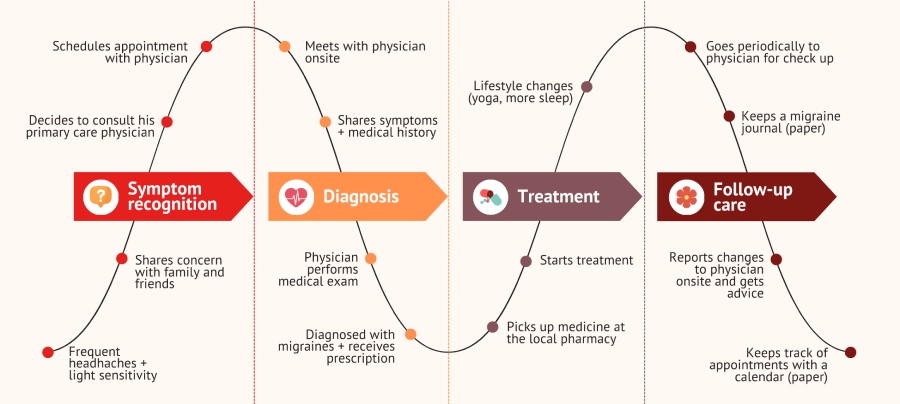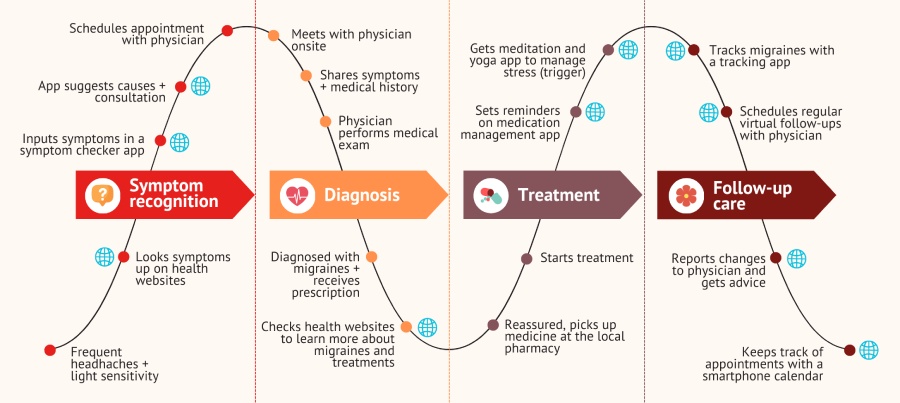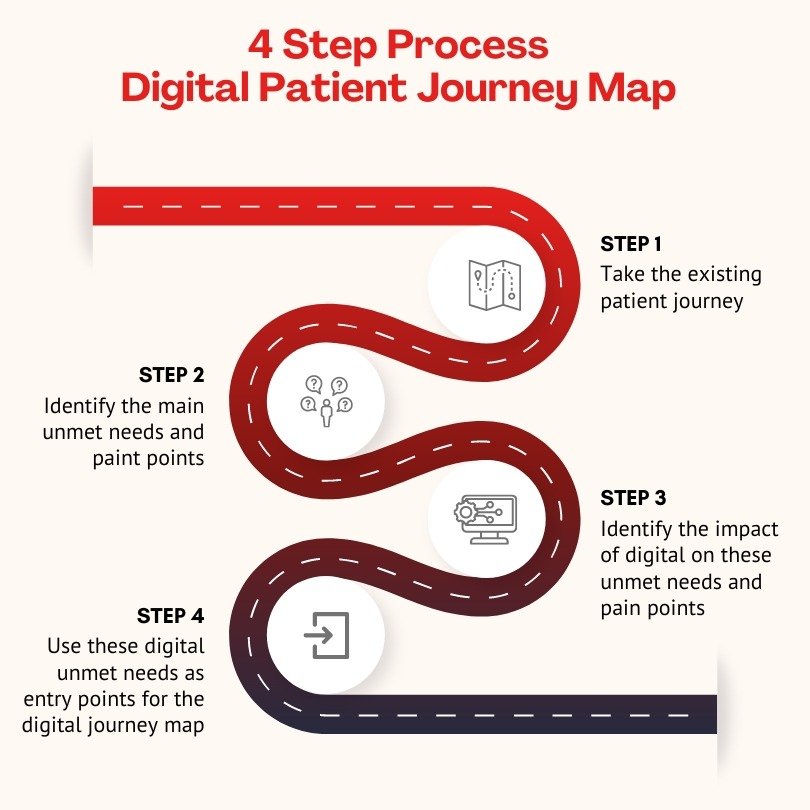When was the last time you updated your patient journeys?
Let me answer this for you: Probably too long ago!
How many digital activities were included?
Probably none, one or two if you are lucky.
In today’s fast-paced healthcare landscape, the way patient journeys were built a few years ago has become obsolete.
With the advent of the digital age, patients now have unprecedented access to health information, transforming the way they navigate their care.
But here’s the catch: traditional patient journeys fail to capture this shift.
That’s where the digital patient journey comes in.
This isn’t just a buzzword; it’s a must-have to uncover opportunities to improve patient journeys in an increasingly digital world.
Let’s see why the traditional model falls short, how the digital patient journey is paving the way for a patient-centric revolution and how mapping it can help uncover business opportunities.
Key Takeaways
Why the traditional patient journey approach is outdated
The patient journey refers to the complete process/experience that an individual goes through from the initial recognition of a health issue or need for medical attention, through diagnosis, treatment, and follow-up care.
The traditional way to approach the patient journey is to base it on data collected from HCPs. This HCP-centric approach made sense in the pre-digital era, as patients had very limited ways to inform themselves and therefore relied almost entirely on HCPs throughout the whole journey.
But in the current digital era, this approach is obsolete.

Patients now have widespread access to health-related information online (both accurate and misleading), at every stage of their journey, from symptom identification on health websites to self-monitoring apps.
As a matter of fact, 7% of Google’s daily searches are health-related (this represents about 70k searches per minute).
This availability of health info online has a huge impact on the patient’s journey and entails three key implications:
- Patients are more and more in control of their journey. They play an active role in their care and don’t simply follow physicians’ recommendations
- There are more touchpoints to consider than ever. For example, there are now several steps that happen online between symptom recognition and the actual visit to the physician’s office.
- The data used to build the patient journey needs to evolve from an HCP-centric to a patient-centric approach.
The impact of digital on the patient journey
Considering the impact of digital on the patient’s journey, it’s crucial to take digital touchpoints into consideration and adapt your patient journey accordingly by crafting a digital patient journey.
It’s important to understand that a digital patient journey doesn’t only include digital touchpoints, but “traditional” touchpoints as well (eg. in-person visit to the physician) and the typical stages of the journey (symptom recognition, diagnosis,..) remain the same.
Let’s have a look at an example of transition from a traditional patient journey to a digital patient journey. Meet Tom, a patient suffering from recurrent headaches and sensitivity to light. 👇
Traditional patient Journey
(Click on the stages below the image for more detailed touchpoints)

Symptom recognition
- Tom experiences frequent headaches and sensitivity to lights
- He consults his family and friends about his symptoms
- Based on discussions, he decides to go to his primary care physician
- Tom schedules an appointment with his primary care physician
Diagnosis
- During the consultation, Tom describes his symptoms, and his physician reviews his medical history
- The physician also performs a medical exam (neurological tests, blood pressure, pulse…)
- Based on the symptoms and examination, the physician diagnoses Tom with migraines, presents the options and gives him a prescription for triptans and beta-blockers
Treatment
- Based on the doctor’s recommendations, Tom goes to his local pharmacy to get his medication
- Tom can now start his pharmacological treatment
- Based on family and doctor recommendations, Tom also started doing some lifestyle changes to prevent migraine triggers (daily yoga routine every morning, more sleep…)
Follow-up care
- Tom returns to his primary care physician periodically for check-ups and medication adjustments
- Tom is keeping a migraine journal to figure out what triggers his attacks
- He reports any changes in his symptoms and receives advice accordingly
- Tom keeps track of his appointments using a paper calendar
Digital patient journey
(Click on the stages below the image for more detailed touchpoints)

Symptom recognition
- Tom experiences frequent headaches and sensitivity to lights
- He looks the symptoms up on Google and browse several websites such as WebMD and Doctossimo
- In parallel, he inputs his symptoms into a symptom checker app
- The app suggests potential causes and advises Tom to schedule a (virtual) consultation
- Tom schedules an appointment with his primary care physician
- Alt: Tom schedules a virtual consultation with his primary care physician via a telemedicine platform
Diagnosis
- During the consultation, Tom describes his symptoms, and his physician reviews his medical history
- The physician also performs a medical exam (neurological tests, blood pressure, pulse…)
- Based on the symptoms and examination, the physician diagnoses Tom with migraines, presents the options and gives him a prescription for triptans and beta-blockers
- While sitting in his car Tom browses healthcare websites on his smartphone to learn more about migraines
- He also looks into treatment options, including the prescribed triptans and beta-blockers, to make sure this is the best for him (safe, effective…)
Treatment
- Based on the doctor’s recommendations and reassured by what he read online, Tom goes to his local pharmacy to get his prescribed medication
- Tom can now start his pharmacological treatment
- He sets up reminders on his medication management app to ensure he takes his beta-blockers daily, as prescribed.
- Tom also downloads a meditation and yoga app recommended by his physician to help manage stress, a trigger for his migraines.
Follow-up care
- Tom tracks his migraine frequency and severity using a migraine tracking app.
- He schedules virtual follow-up appointments with his physician every three months.
- During these appointments, Tom shares updates on his symptoms and medication adherence
- His physician adjusts his medication as needed based on the information provided
- Tom receives automated reminders for his upcoming appointments through the telemedicine platform and his smartphone calendar
From a traditional to a digital patient journey map
Quick reminder: a patient journey map is a visual representation of the patient journey enabling us to:
- Get a holistic understanding of the patient experience
- Identify patients’ unmet needs and pain points in the journey
- Highlight opportunities to improve the journey
- Find ways to influence patients across the stages/touchpoints of the journey
- Better integrate channels (eg. Seamless integration of sales reps and MSLs, conferences and congresses)
- Improve personalisation (by gathering interactions, feedback…)
Here is where it gets interesting…
To transition from a traditional to a digital patient journey map, you don’t need to start from scratch (even though market research agencies tend to recommend it)
From experience, at phamax Digital we believe that the digital patient journey is simply a continuity of the traditional patient journey and not something completely different. Digital leverage points are already there, you just need to ask the right questions to highlight patients’ pain points and unmet needs from a digital point of view.
In short, mapping the digital patient journey is about assessing the impact of digital on the traditional patient journey and uncovering opportunities to improve the journey through digital channels.
The digital patient journey mapping process looks like this:

How to map the digital patient journey
Following the process outlined just above, here is how to map a digital patient journey based on your existing “traditional” patient journey.
Identify the main patients’ unmet needs and pain points
As I mentioned before, in today’s digital landscape, patients actively engage in their healthcare journey and their needs should be at the centre of your business decisions.
The first step in adopting a patient-centric approach to mapping their journey involves pinpointing the unmet needs and pain points of patients at each phase of their current patient journey.
The BECI framework from IQVIA highlights 4 dimensions to consider in order to uncover patients’ unmet needs.
- Behavioural needs: The elements that have an impact on a patient’s behaviour (emotions, surroundings or the presentation of treatment choices)
- Emotional needs: The need for a patient to feel understood and acknowledged
- Clinical needs: The gaps in the delivery and practice of healthcare (eg. lack of rare disease awareness from HCPs)
- Informational needs: The need for a patient to have access to their health information (eg. possible adverse effects)
For example, you might discover that, in the monitoring stage of the patient journey, there is a tendency for poor treatment adherence because patients believe that the treatment is ineffective (behavioural needs)
Identify the impact of digital sources
Now that you have your list of patients’ pain points and unmet needs, you need to find out the impact of digital on these, at every step of the journey.
If we take our example above, this is about identifying whether digital sources contribute to the issue of poor treatment adherence. It could be that patients read that the treatment is ineffective on online patient communities, or social media.
Use these digital unmet needs and paint points as entry points
This step is about identifying opportunities to improve and influence the patient journey, based on the pinpointed unmet needs and pain points. This process includes identifying gaps in existing digital solutions from both your company and other companies.
Back to our example, you need to ask yourself what you can do to improve treatment adherence and change the perception of patients regarding the lack of effectiveness of the treatment. For instance, a solution could be working with patient influencers to educate patients and provide stats that prove the effectiveness of the treatment.
Conclusion
The transition towards digital patient journeys is not just a modern trend but a critical update to align with the evolving healthcare landscape. This shift from traditional models to ones that incorporate digital touchpoints directly addresses the changing needs and behaviors of patients, offering them more personalized and accessible care. For healthcare providers and businesses, adopting a digital patient journey approach is essential for enhancing patient engagement, improving health outcomes, and seizing new opportunities for growth. Embracing this digital transformation allows us to look beyond the challenges, envisioning a future where healthcare is seamlessly integrated, patient-centered, and driven by digital innovation
Thankfully, we are here to help. You can find free resources in the phamax Digital Academy or reach out to find out how our wingmen can work with you directly.
